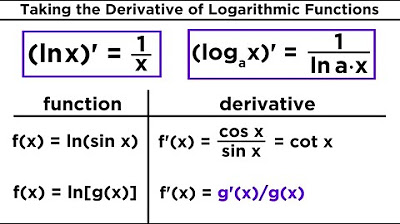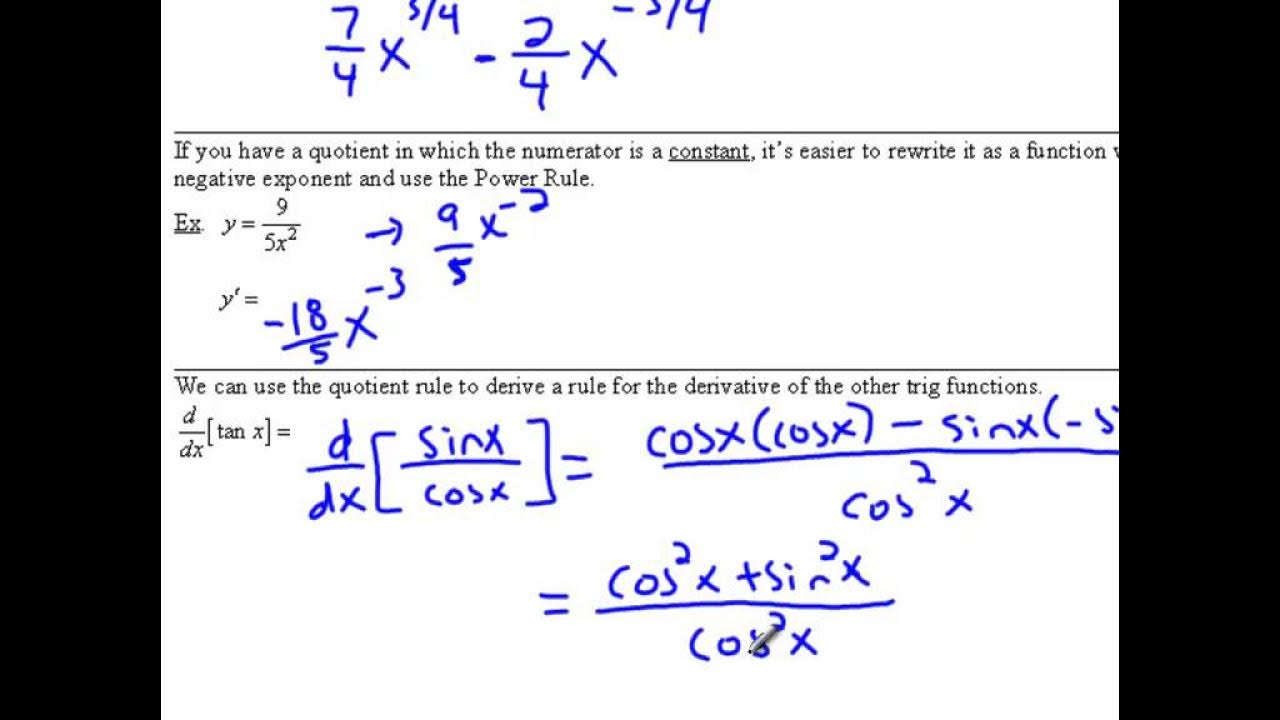Applying the chain rule twice | Advanced derivatives | AP Calculus AB | Khan Academy
TLDRThe video script discusses the process of finding the derivative of a complex function, specifically Y = sin(X)^3. The instructor uses the chain rule to break down the problem, first differentiating the outer function and then applying the chain rule again to differentiate the inner function, sin(X)^2. The explanation is clear and methodical, leading to the final derivative, which is 6X * sin^2(X) * cos(X). This content is valuable for students learning calculus, as it demonstrates the application of fundamental rules to more complex problems.
Takeaways
- 📚 The problem involves finding the derivative of a function, Y = sin(X)^3, with respect to X.
- 🧠 The instructor suggests using the chain rule as the primary method to tackle the problem due to the complexity of the expression.
- 🔗 The chain rule is applied by taking the derivative of the outer function with respect to the inner function, and then multiplying by the derivative of the inner function itself.
- 🌀 The expression sin(X)^3 can be thought of as (sin(X))^2 raised to the power of 3, which helps in applying the chain rule.
- 📈 The derivative of (sin(X))^3 with respect to X involves taking the derivative of sin(X) squared first, and then applying the power rule.
- 🌟 The derivative of sin(X) with respect to X is cos(X), which is a fundamental concept used in the solution.
- 🔢 The derivative of X squared with respect to X is found using the power rule, resulting in 2X.
- 🔍 The process requires multiple applications of the chain rule to fully differentiate the given function.
- 📊 The final expression for the derivative DY/DX is 6X * sin^2(X) * cos^2(X), after applying the chain rule and power rule as necessary.
- 🎓 The solution demonstrates the importance of understanding and applying fundamental calculus rules such as the chain rule and power rule.
- 💡 This example serves as a reminder that complex expressions can be simplified and solved by breaking them down into more manageable parts.
Q & A
What is the given function Y in the script?
-The given function Y is sin^3(X), which means the sine of X is raised to the third power.
What is the derivative of Y with respect to X, denoted as dY/dx or Y prime?
-The derivative of Y with respect to X is the rate of change of sin^3(X) concerning X, which is a mathematical expression that we need to calculate using differentiation rules.
How does the instructor suggest tackling the derivative of sin^3(X)?
-The instructor suggests using the chain rule to tackle the derivative of sin^3(X) since it involves a composite function.
What is the chain rule, and how does it apply to this problem?
-The chain rule is a differentiation technique used when dealing with composite functions. It states that the derivative of a composite function is the derivative of the outer function evaluated at the inner function times the derivative of the inner function. In this problem, the outer function is sin^3, and the inner function is X (or sin(X) in the nested form).
What is the first step in applying the chain rule to sin^3(X)?
-The first step in applying the chain rule to sin^3(X) is to identify the outer and inner functions. Here, the outer function is sin^3, and the inner function is X (or sin(X) in the nested form).
How does the instructor describe the process of differentiating sin^3(X)?
-The instructor describes the process as a two-step chain rule application. First, differentiate the outer function with respect to the inner function, which gives 3 times the inner function squared. Then, differentiate the inner function (sin(X)) with respect to X, which involves using the chain rule again, resulting in cos(X) times the derivative of X^2 (which is 2X using the power rule).
What is the final expression for the derivative of sin^3(X)?
-The final expression for the derivative of sin^3(X) is 3sin^2(X)cos(X) times 2X, which simplifies to 6Xsin^2(X)cos(X).
What differentiation rules are used in the process of finding the derivative of sin^3(X)?
-The differentiation rules used in the process are the chain rule, the power rule for the derivative of X^2, and the trigonometric derivative rule for differentiating sin(X), which yields cos(X).
How does the instructor emphasize the importance of the chain rule in this context?
-The instructor emphasizes the importance of the chain rule by stating that it allows us to differentiate composite functions and that it is essential for tackling expressions like sin^3(X) where a function is raised to a power.
What is the significance of the orange parentheses and brackets mentioned in the script?
-The orange parentheses and brackets represent the inner function (sin(X)) and its derivative (cos(X)) in the chain rule application. They are used to visually indicate the parts of the expression that are being manipulated during the differentiation process.
What is the role of the power rule in finding the derivative of sin^3(X)?
-The power rule is used to find the derivative of X^2 within the chain rule application. It helps to simplify the expression by determining that the derivative of X^2 is 2X.
Outlines
📚 Calculus - Derivative of a Complex Function
This paragraph introduces a complex calculus problem involving the derivative of a function where Y is defined as the sine of X squared, raised to the third power. The instructor explains that this is not a straightforward problem due to the complexity of the expression. The solution approach involves applying the chain rule multiple times. The first step is to differentiate the outer function with respect to the inner function, which in this case is the sine of X squared raised to the power of three. This results in three times the sine of X squared, multiplied by the derivative of the inner function with respect to X. The inner function's derivative is then found by differentiating sine of X squared, which requires applying the chain rule again. This leads to the cosine of the inner function (X squared) multiplied by the derivative of X squared, which is simply 2X. Finally, the derivative of the entire expression with respect to X is calculated as 6X times the sine squared of X squared, multiplied by the cosine of X squared. This comprehensive explanation provides a clear understanding of how to apply the chain rule to complex functions in calculus.
Mindmap
Keywords
💡Derivative
💡Chain Rule
💡Trigonometric Function
💡Power Rule
💡Sine of X Squared
💡Cosine Function
💡Algebraic Simplification
💡Rate of Change
💡Nested Functions
💡Differentiation
💡Mathematical Expressions
Highlights
The main topic of the transcript is the calculation of the derivative of a complex trigonometric function with respect to X.
The function in question involves the sine of X raised to the third power, expressed as Y = sin^3(X).
The derivative is denoted as dY/dX or Y prime, and the process to find it involves the use of the chain rule.
The chain rule is applied because the expression has an outer function (sin^3) and an inner function (X squared).
The derivative of the outer function with respect to the inner function is the first step in the chain rule process.
The derivative of sin^3(X) with respect to X involves raising the inner function (sin(X)^2) to the power of 3 and multiplying by 3.
The inner function sin(X)^2 is identified as the 'something' in the explanation, which will be used in the chain rule.
The chain rule dictates that the derivative of the outer function times the derivative of the inner function equals the derivative of the entire expression.
The derivative of sin(X)^2 with respect to X requires the use of the chain rule again, this time for the sine function.
The derivative of sin(X) is cosine of X, which is used in the second application of the chain rule.
The derivative of X squared with respect to X is found using the power rule, resulting in 2X.
The final expression for dY/dX involves multiplying the results from each step of the chain rule and power rule applications.
The result is 6X times sin^2(X) times cos^2(X), demonstrating the successful use of the chain rule and power rule in a complex derivative calculation.
The process emphasizes the importance of understanding the chain rule for tackling complex derivatives involving composite functions.
The explanation serves as a clear example of how to break down and simplify the process of finding derivatives for more complicated functions.
The transcript provides a step-by-step guide that is beneficial for learners looking to understand the application of calculus concepts in a practical manner.
The use of color and visual aids in the explanation helps to clarify the process and distinguish between different components of the calculation.
The transcript showcases the interconnectedness of mathematical concepts, such as the chain rule, power rule, and trigonometric functions.
The detailed walkthrough of the derivative calculation process can be used as a reference for solving similar problems in calculus.
The transcript's content is a valuable resource for educational purposes, particularly in the field of mathematics and calculus.
Transcripts
Browse More Related Video

Chain rule | Derivative rules | AP Calculus AB | Khan Academy

Worked example: Derivative of cos_(x) using the chain rule | AP Calculus AB | Khan Academy

Exponential functions differentiation | Advanced derivatives | AP Calculus AB | Khan Academy

Derivatives of Logarithmic and Exponential Functions

The Chain Rule

Product and Quotient Rule
5.0 / 5 (0 votes)
Thanks for rating: